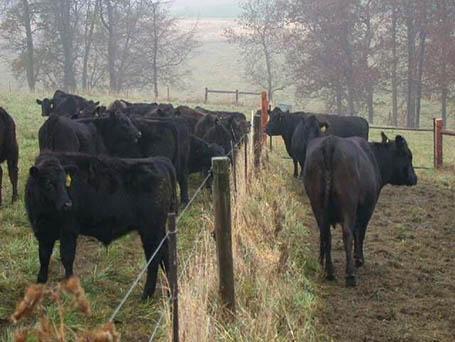Weaning Calves on Pasture
 Beef calves often experience stress during the time of weaning, and limiting this stress can help daily gain. Four main types of stress affect calves: physical, environmental, nutritional, and social. These issues can be avoided or at least minimized with proper calf weaning.
Beef calves often experience stress during the time of weaning, and limiting this stress can help daily gain. Four main types of stress affect calves: physical, environmental, nutritional, and social. These issues can be avoided or at least minimized with proper calf weaning.
Physical stress can occur during long periods of standing in working facilities, mishandling in the working chute, hauling to weaning facility, etc. Castration and/or dehorning can also increase the level of stress experienced at weaning if these processes occur at weaning time. Castration at birth and vaccinating before weaning will help decrease this stress.
Another form of stress is environmental, which can be either man-made or climatic. The weaning pen is the main human-induced environmental stress. Transferring calves from a clean pasture to a dry-lot can add stress as they are not familiar with these new surroundings. Also, moving calves to a dusty dry-lot where they walk around in a confined space turning up dust can cause respiratory problems and decreased weight gain. Climatic issues such as rain, ice, and snow are out of our control, but we can try to plan weaning time to avoid these conditions. Social stress is the removal of the calf from its mother. This is inevitable when weaning, but the amount of stress can be decreased by using cross-fence weaning.
The cross-fence weaning method is where the calves are separated from the cows by a good fence that will keep them apart. Remaining in “nose to nose” contact with the cow keeps calves calmer and separation is not such a large factor. This can be effective even with a small distance between the cows and calves, but where they are still able to see each other.
Nutritional stress occurs when calves are changed from a milk and pasture diet to a stored forage and grain diet. Having high quality pasture available to calves at weaning time is important both in the spring and fall. For fall weaning, calves can graze fields cut for hay which are beginning to regrow, or stock-piled fescue fields. Pastures used for fall weaning should be grazed or clipped between mid-August and mid-September to allow enough time for regrowth. For spring-weaned calves, vegetative-growth provides an excellent quality forage as long as the grasses are maintained and not grazed too young or too mature. Grasses will generally start vegetative regrowth in April and May when temperatures begin to get warmer. Recommendations are to turn calves into a pasture when grasses are 8-12 inches tall and graze until grasses are 3-4 inches.
Pasture weaning offers a low-stress alternative to the conventional dry-lot weaning programs. Pasture weaning reduces the environmental and nutritional stress because calves are accustomed to pasture and the diet does not change. Demonstrations have shown that calves weaned on pasture and supplemented gain more weight than calves that are weaned in a dry-lot. New Mexico researchers reported that calves weaned on pasture had daily gains of 1.57 lb./day while dry-lot weaned calves gained 0.95 lb./day during the first 3 weeks post-weaning. The advantage was lost at the end of the 42-45 day backgrounding period. University of Kentucky Beef Specialist, Jeff Lehmkuhler, conducted a field demonstration with two different herds. One herd was weaned on pasture with supplement, while a second herd was weaned in dry-lot pens. Gains for pasture weaned calves were near 4 pounds per day and only 1.2 lb. for dry-lot calves during the first 7-9 days post-weaning. During the fall of 2013, Lehmkuhler worked with a producer in Anderson County where calves were weaned on pasture with supplement. Calves gained about 2.25 lb./day the first 19 days after weaning. Other studies have shown that pasture weaning is an effective way to keep beef calves healthy and productive during the weaning process.
Weaning calves on pasture is an option for cow-calf producers in Kentucky which can improve health and performance of calves during the weaning period. For this method to be successful, planning has to be done in advance regarding pasture quality and availability. Providing calves with a high quality forage and a clean environment is critical to performance during weaning. When weaning try to keep the stress at a minimum to improve animal health and performance.
Categories:
Fall
Animal Management


